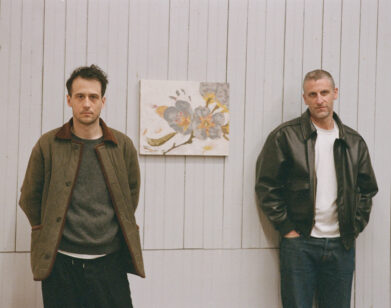Alex Da Corte
Unquestionably, 29-year-old artist Alex Da Corte is an heir to the American school of pop. But Da Corte, who was born in Camden, New Jersey, also lived in Caracas, Venezuela, until he was eight, and some of South America’s appreciation for bright, lysergic colors, swirling surfaces, andcelebratory life-and-death imagery can be seen in his rambunctious multimedia productions. “There is a certaindecorative motif to Latin American culture that inspires me,” he says. “Like the festive nature of the Day of the Dead and the life-size piñatas with lots of sequins and glitz.”
Da Corte, who is currently at Yale University getting his M.F.A. in sculpture, seems to revel in that kind of gleeful explosion of candy and papier-mâché. His sculptures operate partly as high aesthetic comedy—one of his first serious works was a hand-sewn 15-foot-long ketchup bottle madeof vinyl—and more recent projects have included stuffed-animal snakes, rattlers made of crystals and acrylic fingernails, and homemade batches of cola repurposed on the floors of P.S. 1 as dried, minimalist grids.
Nevertheless, this pop appeal doesn’t come without an ensuing punch in the stomach. Many of Da Corte’s sculptures turn mournful or macabre—or just plain heartbreaking—right in the center of the party. In one work, a Christmas tree appears almost strangled by the extension cord that allows a second tree to be illuminated. In others, a bouquet of flowers is on fire, happy lightbulb faces are mixed with frowns, anddeclarations of love are amended with slurs like “so much it makes me sick.” “The idea for a work trickles down from everything I see, watch, and collect,” Da Corte says. “I take one idea and I want to add to it, flip it, or just turn it on its head. That’s how it mashes into my own.” Currently, for his thesis, Da Corte is building an elaborate sculpture based on Rainer Werner Fassbinder’s cult classic film The Bitter Tears of Petra von Kant (1972) that includes a fur island and the figure of Petra floating in the center and holding a hose that shoots out soda. “It’s her choice,” Da Corte explains. “She can leave the island or stay, but the soda that is pouring out is slowly cutting her off.” It is an image that neitherFassbinder nor the ad execs at Coca-Cola might have ever envisioned, but it is one that says everything about consumption and self-destruction—the interchangeable anthems ofDa Corte’s work.
See more of Alex Da Corte’s work here.







